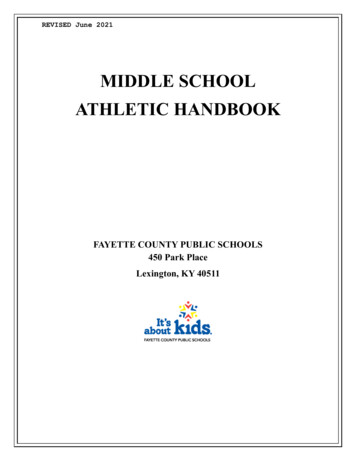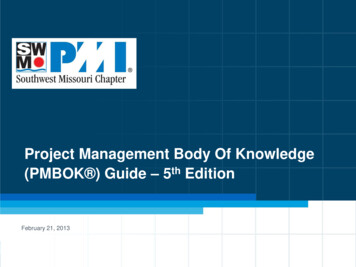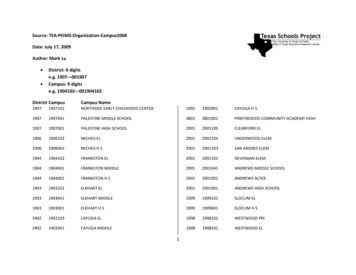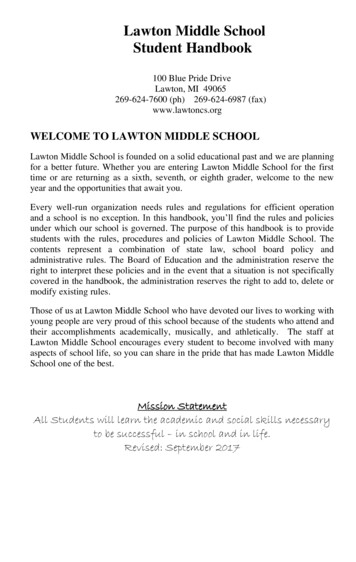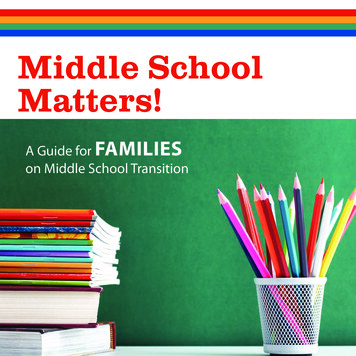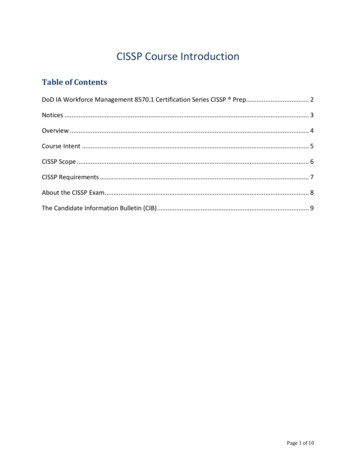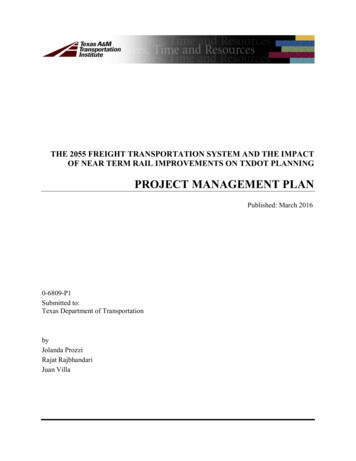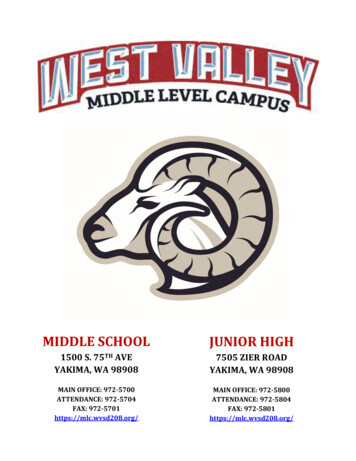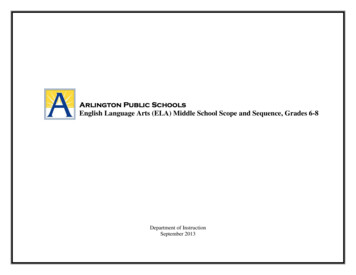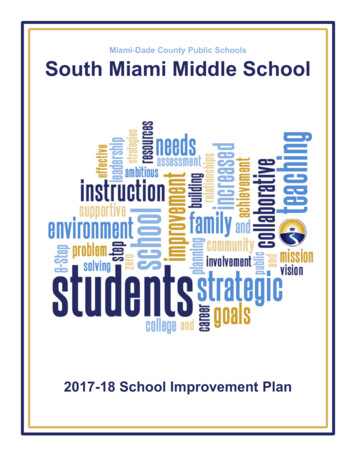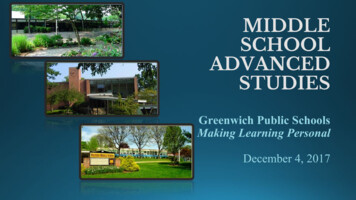
Transcription
THE NEW YORK CITY DEPARTMENT OF EDUCATIONJ O E L I . K L E I N , ChancellorCarmen Fariña, Deputy Chancellor for Teaching & LearningLaura Kotch, Executive DirectorOffice of Curriculum and Professional DevelopmentJulia A. Rankin Ph.D., DirectorDepartment of the Sciences52 Chambers Street, Room 208New York, NY 10007 (212) 374-0465 Fax: (212) 374-5901/5763 jrankin2@nycboe.netMiddle School (6-8) Scope and SequenceScience
Middle School Science Scope and Sequence Advisory TeamNAMEAbel, JudithO’Raffity, ElizabethHashim, ShehnazBethune, CathyTalty, MarkAwadalleh, NadyaPhelps, DawnetteHartnett, BarbaraZadrozny, ChristineAckie, AuburnWhitter, SharonDamari, MarianitaCambier, MichelleCastro, MiriamDowd, DonnaGartu, ChristinaMiller, JenniferGrambo, GregoryMobley, Tai AsiaPillersdorf, DianeKleppel, RobertEdwards, KathyGordon, DoreenRamnauth, LilianaGrover, ReenaMineo, ChristineHirsch, AllanFico, RitaSmith, CharleneScarmato, JosephChung, acherAPTeacherLead rTeacherRISStaff DeveloperTeacherTeacherTeacherTeacherRISStaff Developer/TeacherStaff 55555666777
NAMEMosachio, JosephCrane, SusanHernandez, EdGreen, CharleseRenz, AmyDavis, DerresaChester, JeanSlinger, HazelOlowoyo, OmatayoAzcone, IsabelitoGioe-Cordi, LisaLesmes, MartaRoberts, MeganPonze, KathleenHahn, TraceylnnLukens, WhitneyStaffaroni, KristenNelson, LisaYoung, SheldonCole, JamesFord , SabrinaOyefusi, O.A.Garcia, BonifacioTapia, ZenaidaHenderson, JenelleCoppola, CelesteDistrict 75Ramdass, DerekConvertino, GianninaCallendar, LionelJulia RankinGreg BormanRoy ipalTeacherStaff DeveloperStaff DeveloperPrincipal her7777788888889999991010101010101010Science CoordinatorScience/Literacy CoachTeacher757575Director of ScienceScience SpecialistScience SpecialistCentralCentralCentral
NAMEAdvisorsCalabrisi-Barton, AngelaDegnan, NancyRaia, FedericaMayer, MarcCook, DonMiksic, MarkPOSITIONAffiliationTeacher’s CollegeColumbiaCity CollegeSchool at ColumbiaBank St CollegeQueens CollegeREGION
New York City Department of EducationMiddle School (6-8) Scope and Sequence for ScienceGrade 6: Transformation of Energy; SystemsUnit 1Unit 2Unit 3Unit 4Simple and Complex MachinesWeatherBiodiversityInterdependence Potential and kinetic energyMechanical energyMachines can affect the magnitude or directionof a force required to do work, or the distanceover which that force is applied.Simple machines include the lever, the pulley,the wheel and axle, and the inclined plane.Complex machinesTransformation of energy within simple andcomplex machinesPrinciple of the conservation of energyFriction and machinesGeneral Skills (from NYS Core Curriculum)1. Follow safety procedures in the classroom andlaboratory2. Safely and accurately use the following measurementtools: metric ruler spring scale3. Use appropriate units for measured or calculated values4. Recognize and analyze patterns and trends7. Sequence events8. Identify cause-and-effect relationshipsProperties of Matter Matter is anything that takes up space and hasmass.Solids, liquids, and gasesRelationship between phases of matter andparticle motionDensityHeating and cooling events Principle of the conservation of energyTransfer of heat: radiation, convection, andconductionHeat and its relationship to phase changesExpansion and contractionWeather Weather is the result of complex interactions ofthe atmosphere, hydrosphere, and lithosphere;all weather is caused by the unequal heating ofthe earth’s surface.Light energy vs. heat energyHydrosphere/atmosphere interactions: Watercycle, PrecipitationWeather factors: Pressure, relative humidity,temperature, windAir masses and frontsExtreme weather events: hurricanes, tornadoes,blizzards, droughtKingdoms of Life What makes something “alive”?The cell is a basic unit of structure and functionof living thingsUnicellular vs. multicellular organismsBiological classification systemsClimate and Biomes Food Chains and Food Webs Principle of the conservation of energyFlow of energy and matter through food chainsand food websMethods for obtaining nutrientsRole of producersRole(s) of consumers: idea voresThe role of decomposersGeneral Skills (from NYS Core Curriculum)1. Follow safety procedures in the classroom andlaboratory4. Recognize and analyze patterns and trends6. Develop and use a dichotomous key7. Sequence events8. Identify cause-and-effect relationshipsLiving Environment Skills (from NYS CoreCurriculum)1. Manipulate a compound microscope to viewmicroscopic objectsGeneral Skills (from NYS Core Curriculum)2. Determine the size of a microscopic object using a1. Follow safety procedures in the classroom andcompound microscopelaboratory6. Classify living things according to a student-generated2. Safely and accurately use the following measurementscheme and an established schemetools:7. Interpret and/or illustrate the energy flow in a food metric rulerchain, energy pyramid, or food webThe Scope and Sequence should be used in conjunction with New York State’s Science Core CurriculumClimatic regionsBiomes: Tundra, Tropical Rain Forest,Temperate Forests, Grasslands, DesertSeasonal variationsEffect of elevationGlobal Warming: natural cycles vs. humanimpactEcosystems and Interdependence Populations and definition of speciesCommunitiesEcosystems (including basic abiotic factors suchas water, nitrogen, CO2, and oxygen)Factors affecting the population growth oforganisms -- Predator /prey relationshipsRelationships among organisms: beneficial andharmfulEffects of environmental changes on humansand other populationsAdaptations for survival Thermoregulation in plants and animalsLocomotionGeneral Skills (from NYS Core Curriculum)1. Follow safety procedures in the classroom andlaboratory2. Safely and accurately use the following measurementtools: thermometer3. Use appropriate units for measured or calculated values4. Recognize and analyze patterns and trends8. Identify cause-and-effect relationships9. Use indicators and interpret results
New York City Department of EducationMiddle School (6-8) Scope and Sequence for ScienceGrade 6: Transformation of Energy; SystemsUnit 1Unit 2 balance graduated cylinder thermometer3. Use appropriate units for measured or calculatedvalues4. Recognize and analyze patterns and trends5. Classify objects according to an established schemeand a student-generated scheme7. Sequence events8. Identify cause-and-effect relationshipsUnit 39. identify structure and function relationships inorganismsPhysical Setting Skills (from NYS Core Curriculum)1. Given the latitude and longitude of a location, indicateits position on a map and determine the latitude andlongitude of a given location on a map7. Generate and interpret field maps includingtopographic and weather maps8. Predict the characteristics of an air mass based on theorigin of the air mass9. Measure weather variables such as wind speed anddirection, relative humidity, barometric pressure, etc10. Determine the density of liquids, and regular- andirregular-shaped solidsThe Scope and Sequence should be used in conjunction with New York State’s Science Core CurriculumUnit 4Living Environment Skills (from NYS CoreCurriculum)6. Classify living things according to a student-generatedscheme and an established scheme9. Identify structure and function relationships inorganismsPhysical Setting Skills (from NYS Core Curriculum)1. Given the latitude and longitude of a location, indicateits position on a map and determine the latitude andlongitude of a given location on a map5. Use a magnetic compass to find cardinal directions6. Measure the angular elevation of an object, usingappropriate instruments7. Generate and interpret field maps includingtopographic and weather maps
New York City Department of EducationMiddle School (6-8) Scope and Sequence for ScienceGrade 7: Cycles of Matter and Energy; Formand Function; ClassificationUnit 1Unit 2Unit 3Unit 4GeologyInteractions Between Matter and EnergyDynamic Equilibrium: the Human AnimalDynamic Equilibrium: Other OrganismsEarth as a System Layersandcomposition:Lithosphere,Hydrosphere, Atmosphere, BiosphereProperties of Sound and Light Rocks and Minerals Rock cycleClassification of rocks: Sedimentary,metamorphic, and igneous rocksProperties of minerals including densityErosion and weatheringFossils and Earth’s History Where fossils are foundDating of rocks: Absolute and relative ageThe importance of the fossil recordPlate Tectonics Theory of plate movement and evidencesupporting the theoryConvection currentsBuoyancy (relative density)Sea-floor spreadingEarthquakes: faulting and folding of the earth’scrustVolcanoesMountain buildingTopography of Earth’s surfaceGeneral Skills (from NYS Core Curriculum)1. Follow safety procedures in the classroom andlaboratory2. Safely and accurately use the following measurementtools: metric rulerElectromagnetic energyWave behavior- Light- reflection and refraction- Vibrations and sound wavesProperties of matter The properties of materials, such as: density,conductivity, magnetic materials, and solubilityElements and compoundsAtoms and moleculesThe Periodic Table as a way of organizing theelementsPhysical and Chemical changes Characteristics of physical changes:- Review of phase change/states of matter-Mixtures and solutions-Temperature and its effect on solubility Characteristics of chemical changesUnderstanding Chemical Reactions:Photosynthesis and Respiration Law of Conservation of MassEnergy changes in chemical reactionsLaw of Conservation of EnergyInteractions among atoms and/or moleculesresult in chemical reactions.(PHOTOSYNTHESIS AND RESPIRATION as contextfor chemical change as well as transformation of energy:Light, chemical; heat)Levels of Organization Cells- structure and functionTissues; organs; systems; organismThe Human Body Maintaining homeostasis: The human bodysystemso Digestiveo Respiratoryo Circulatoryo Excretoryo Skeletal and MuscularObtaining energyObtaining nutrientsRegulation of the internal environmentMetabolismResponding to the external environment(Nervous system)General Skills (from NYS Core Curriculum)1. Follow safety procedures in the classroom andlaboratory2. Safely and accurately use the following measurementtools: metric ruler stopwatch (for pulse rate) thermometer3. Use appropriate units for measured or calculated values7. Sequence events8. Identify cause-and-effect relationshipsThe Scope and Sequence should be used in conjunction with New York State’s Science Core CurriculumOther Animals Animal structures and systemsMaintaining homeostasisObtaining energyObtaining nutrientsRegulation of the internal environmentMetabolismResponding to the external environmentPlants Plant structures and systemsMaintaining homeostasisObtaining energyObtaining nutrientsRegulation of the internal environmentMetabolismResponding to the external environmentOne-celled Organisms Unicellular vs. multicellular organismsMaintaining homeostasisObtaining energyObtaining nutrientsRegulation of the internal environmentMetabolismResponding to the external environmentGeneral Skills (from NYS Core Curriculum)1. Follow safety procedures in the classroom andlaboratory2. Safely and accurately use the following measurementtools: metric ruler3. Use appropriate units for measured or calculated values
New York City Department of EducationMiddle School (6-8) Scope and Sequence for ScienceGrade 7: Cycles of Matter and Energy; Formand Function; ClassificationUnit 1 balance graduated cylinder3. Use appropriate units for measured or calculated values4. Recognize and analyze patterns and trends5. Classify objects according to an established schemeand a student-generated scheme7. Sequence events9. Use indicators and interpret resultsLiving Environment Skills (from NYS CoreCurriculum) (if use microscopes to look at crystals)1. Manipulate a compound microscope to viewmicroscopic objects2. Determine the size of a microscopic object, using acompound microscopePhysical Setting Skills (from NYS Core Curriculum)1. Given the latitude and longitude of a location, indicateits position on a map and determine the latitude andlongitude of a given location on a map2. Using identification tests and a flow chart, identifymineral samples3. Use a diagram of the rock cycle to determinegeological processes that led to the formation of aspecific rock type4. Plot the location of recent earthquake and volcanicactivity on a map and identify patterns of distribution5. Use a magnetic compass to find cardinal directions6. Measure the angular elevation of an object, usingappropriate instruments7. Generate and interpret field maps includingtopographic and weather maps10. Determine the density of liquids, and regular- andirregular-shaped solids11. Determine the volume of a regular- and an irregularshaped solid, using water displacement13. Determine the identity of an unknown element, usingphysical and chemical propertiesUnit 2General Skills (from NYS Core Curriculum)1. Follow safety procedures in the classroom andlaboratory2. Safely and accurately use the following measurementtools: balance graduated cylinder thermometer spring scale voltmeter3. Use appropriate units for measured or calculated values4. Recognize and analyze patterns and trends5. Classify objects according to an established schemeand a student-generated scheme7. Sequence events9. Use indicators and interpret resultsUnit 3Living Environment Skills (from NYS CoreCurriculum)1. Manipulate a compound microscope to viewmicroscopic objects (look at different types of cells andtissues)2. Determine the size of a microscopic object using acompound microscope7. Interpret and/or illustrate the energy flow in a foodchain, energy pyramid, or food web (with regard tonutrients and calories)8. Identify pulse points and pulse rates9. Identify structure and function relationships inorganismsPhysical Setting Skills (from NYS Core Curriculum)10. Determine the density of liquids, and regular- andirregular-shaped solids12. Using the periodic table, identify an element as ametal, nonmetal, or noble gas13. Determine the identity of an unknown element, usingphysical and chemical properties14. Using appropriate resources, separate the parts of amixture15. Determine the electrical conductivity of a material,using a simple circuitThe Scope and Sequence should be used in conjunction with New York State’s Science Core CurriculumUnit 44. Recognize and analyze patterns and trends5. Classify objects according to an established schemeand a student-generated scheme6. Develop and use a dichotomous key7. Sequence events8. Identify cause-and-effect relationshipsLiving Environment Skills (from NYS CoreCurriculum)1. Manipulate a compound microscope to viewmicroscopic objects2. Determine the size of a microscopic object using acompound microscope3. Prepare a wet mount slide4. Use appropriate staining techniques6. Classify living things according to a student-generatedscheme and an established scheme9. Identify structure and function relationships inorganisms
New York City Department of EducationMiddle School (6-8) Scope and Sequence for ScienceGrade 8: Constancy and ChangeUnit 1Reproduction, Heredity, and EvolutionUnit 2Humans in their Environment: Needs andTradeoffsReproductive Patterns and the Continuity ofLifeNatural Resources and Energy Asexual Reproduction e.g. Binary fission inunicellular organisms, plant budding,Sexual Reproduction – formation of gametesCompare and contrast results, contexts, advantagesand disadvantages of each method Patterns of Development and the Continuityof Life Patterns of development in plantsPatterns of development in animalsCell division-growth, maintenance, and repair- Cancer is the result of abnormal cell divisionHeredity Genes and DNAMendelian geneticsMutationsRole of Sexual and Asexual Reproduction inHuman Growth and Development The role of the sperm and eggHuman reproductive systemHormonal regulation: Endocrine systemPatterns of development: cell division andgenetic expressionGenetic diseasesGenetic engineering, esp. cloning Energy needsRenewable and non-renewable sources of energyMaterial needsRenewable and non-renewable sources ofmaterialsEnvironmental concerns: Acquisition anddepletion of resources; Waste disposal; Land useand urban growth; Overpopulation; GlobalWarming; Ozone depletion; Acid rain; Airpollution; Water pollution; Impact on otherorganismsEnergy conservationNutrition and Food Choices: Impact on theEnvironment and on our HealthEnvironment: Environmental Toxins: pesticides andherbicides; fertilizers; organic waste Endangered species: Habitat destruction, overfishing Packaging and solid waste Water issues: depletion; pollutionHomeostasis and Health: Analyzing nutritional value Food –borne illness: Infectious disease and theimmune system (bacteria, parasites) System failures: heart disease; high bloodpressure; colon cancer; epidemics of childhoodobesity and diabetes; osteoporosisUnit 3Unit 4Earth, Sun, Moon SystemForces and Motion on EarthSeasons and Cycles: Relationships amongthe sun, earth and moon Day: rotationYear: revolutionSeasons: Tilt of Earth’s axis of rotationPhases of the MoonEclipsesTidesSolar System Classification of celestial objects: starsincluding the sun; planets; comets; moons; andasteroidsPatterns of motion, frame of reference andposition, direction, and speedObserve, describe, and compare the effects ofbalanced and unbalanced forces on the motion ofobjects- Newton’s First Law of Motion: Inertia- gravityGeneral Skills (from NYS Core Curriculum)1. Follow safety procedures in the classroom andlaboratory2. Safely and accurately use the following measurementtools: metric ruler stopwatch spring scale3. Use appropriate units for measured or calculated values4. Recognize and analyze patterns and trends5. Classify objectsThe Scope and Sequence should be used in conjunction with New York State’s Science Core Curriculum Patterns of motion, frame of reference andposition, direction, and speedNewton’s First Law of InertiaNewton’s Second Law: F ma (conceptualunderstanding as opposed to teaching theformula)Newton’s Third Law: For every reaction there isan equal and opposite reaction; Force as aninteractionGeneral Skills (from NYS Core Curriculum)1. Follow safety procedures in the classroom andlaboratory2. Safely and accurately use the following measurementtools: metric ruler balance stopwatch spring scale3. Use appropriate units for measured or calculated values4. Recognize and analyze patterns and trends8. Identify cause-and-effect relationshipsPhysical Setting Skills (from NYS Core Curriculum)16. Determine the speed and acceleration of a movingobject
New York City Department of EducationMiddle School (6-8) Scope and Sequence for ScienceGrade 8: Constancy and ChangeUnit 1Natural Selection: The Driving MechanismBehind Evolution Sources of variation in organismsAdaptationsCompetitionExtinctionEvidence for evolutionGeneral Skills (from NYS Core Curriculum)1. Follow safety procedures in the classroom andlaboratory4. Recognize and analyze patterns and trends7. Sequence eventsLiving Environment Skills (from NYS CoreCurriculum)1. Manipulate a compound microscope to viewmicroscopic objects (e.g. look at cells undergoingmitosis)2. Determine the size of a microscopic object using acompound microscope5. Design and use a Punnett square or a pedigree chart topredict the probability of certain traits6. Classify living things (evolutionary relationships)8. Identify cause-and-effect relationships9. Identify structure and function relationships inorganismsUnit 2General Skills (from NYS Core Curriculum)1. Follow safety procedures in the classroom andlaboratory2. Safely and accurately use the following measurementtools: (depends on project)3. Use appropriate units for measured or calculated values4. Recognize and analyze patterns and trends7. Sequence events8. Identify cause-and-effect relationships9. Use indicators and interpret resultsUnit 38. Identify cause-and-effect relationshipsPhysical Setting Skills (from NYS Core Curriculum)1. Given the latitude and longitude of a location, indicateits position on a map and determine the latitude andlongitude of a given location on a map[Note: Physical Setting and Living Environment Skillswill vary depending on projects pursued]Living Environment7. Interpret and/or illustrate the energy flow in a foodchain, energy pyramid, or food web9. Identify structure and function relationships inorganisms (within the study of system failures)Physical Setting: Look for opportunities to addressdensity, as this is a significant concept for the ILSEThe Scope and Sequence should be used in conjunction with New York State’s Science Core CurriculumUnit 4
Middle School (6-8) Scope and Sequence for Science The Scope and Sequence should be used in conjunction with New York State's Science Core Curriculum Grade 6: Transformation of Energy; Systems Unit 1 Unit 2 Unit 3 Unit 4 balance graduated cylinder thermometer 3. Use appropriate units for measured or calculated values 4.
